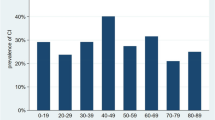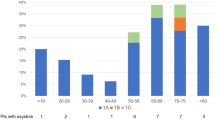Abstract
Objective: The natural history of pediatric patients with severely symptomatic neurocardiogenic syncope is poorly defined respect to the likelihood of remission or symptomatic recurrence along time. We undertook this study to investigate the likelihood of clinical relapse, and to assess the effect of prophylactic pharmacological treatment in the most symptomatic patients.
Methods: Twenty-nine patients with neurocardiogenic syncope were studied at our Institution: 14 (12 ± 3.6 years) highly symptomatic received prophylactic therapy with β-blockers guided by head up tilt (HUT), whereas 15 (12.2 ± 2.7 years) moderately symptomatic received only education to avoid triggering of the vasovagal reflex and to abort forthcoming syncope. Patients were then followed respectively for 33.7 ± 9.0 and 33.3 ± 8.7 months (p = NS).
Results: The average duration of symptoms before HUT was 9.0 ± 4.3 months (range 3–17) for treated patients, and 6.2 ± 2.5 months (range 2–11) for those untreated ( p < 0.05). Treated patients had also a greater number of symptomatic events: 6 ± 2 vs. 2 ± 1 (p < 0.001). During follow up, 9/15 untreated and 6/14 treated patients had at least 1 recurrence, with an odds ratio of 2 (95% CI 0.72–5.49). Clinical events were greatly reduced in both groups at follow up, but treated patients had a significantly greater reduction either of syncopal (p < 0.001) or near syncopal events (p < 0.02). Time to the first recurrence, syncope or near syncope, was shorter for untreated vs treated patients: 5 ± 2 vs. 25 ± 12 months (p < 0.001). Looking at the time course of all clinical recurrences, 23/26 occurred in untreated patients, whereas 7/10 occurred in treated patients within 24 months. An attempt to therapy discontinuation was made after 30 months in 4 patients, and resulted in half of them being asymptomatic, and half with a single minor recurrence.
Conclusions: Spontaneous reduction of symptoms occurs along time in pediatric patients with neurocardiogenic syncope, so that recurrences are very unlikely after 24 months from first diagnosis. Tiered prophylactic therapy may be guided by HUT in selected highly symptomatic patients; β-blockers appear a very effective intervention. Larger, prospective controlled studies are required to investigate the role of any intervention in moderately symptomatic patients.
Similar content being viewed by others
References
Weissler AM, Warren JV. Syncope: pathophysiology and differential diagnosis. In: Hurst JW, Logue RB, Rackley CE, et al., eds. The Heart, New York: McGraw Hill, 1986: 507-29.
Kapoor WN. Diagnostic evaluation of syncope. Am J Med 1991; 90: 91-106.
Samoil D, Grubb BP, Kip K, Kosinski D. Head upright tilt table testing in children with unexplained syncope. Pediatrics 1993; 92:4 26-29.
Sutton R. Vasovagal syncope: clinical presentation, classification and management. In: Aubert AE, Ector H, Stroobandt R, eds. Cardiac Pacing and Electrophysiology. A Bridge to the 21st Century. Dordrecht: Kluwer Academic Publishers, 1994: 15-22.
Grubb BP, Temesy-Armos P, Hahn H, Elliot L. Utility of upright tilt table testing in the evaluation and management of syncope of unknown origin. Am J Med 1991; 90: 6-10.
Chen XC, Chen MY, Remole S, et al. Reproducibility of headup tilt table testing for eliciting susceptibility to neurally mediated syncope in patients without structural heart disease. Am J Cardiol 1992; 69: 755-60.
Sheldon R, Spalwinski J, Killman S. Reproducibility of isoproterenol tilt table test results in patients with syncope. Am J Cardiol 1992; 69: 1300-05.
Grubb BP, Wolfe D, Temesy-Armos P, Hahn H, Elliot L. Reproducibility of head-upright tilt table results in patients with syncope. PACE 1992; 15: 1477-81.
Natale A, Akhtar M, Jazayeri M, et al. Provocation of hypotension during head-up tilt testing in subjects with no history of syncope or presyncope. Circulation 1995; 92: 54-58.
Sheldon R, Rose S, Flanagan P, Koshman ML, Killam S. Risk factors for syncope recurrence after a positive tilt-table test in patients with syncope. Circulation 1996; 93: 973-81.
Linzer M, Pontinon M, Gold DT, et al. Impairment of physical and psychosocial health in recurrent syncope. J Clin Epidemiol 1991; 44: 1037-44.
Grubb BP, Gerard G, Roush K, et al. Differentiation of convulsive syncope and epilepsy with head-up tilt testing. Ann Intern Med 1991; 115: 871-876.
Grubb BP, Temesy-Armos P, Moore J, Wolfe D, Hahn H, Elliot L. Head-upright tilt-table testing in evaluation and management of the malignant vasovagal syndrome. Am J Cardiol 1992; 69:9 04-08.
Sra JS, Jazayeri MR, Avitall B, Akhtar M. Comparison of cardiac pacing with drug therapy in the treatment of peurocardiogenic (vasovagal) syncope with bradycardia or asystole. N Engl J Med 1993; 328:10 85-90.
Sra JS, Murthy VS, Jazayeri MR, et al. Use of intravenous esmolol to predict efficacy of oral beta-adrenergic blocker therapy in patients with neurocardiogenic syncope. J Am Coll Cardiol 1992; 19: 402-08.
Biffi M, Boriani G, Sabbatani P, et al. Malignant vasovagal syncope: a randomised trial of metoprolol and clonidine. Heart 1997; 77:2 68-72.
Boriani G, Biffi M, Bronzetti G, Sabbatani P, Branzi A, Magnani B. Beta-blocker treatment guided by head-up tilt test in neurally mediated syncope. Curr Ther Res 1997; 58:8 42-50.
Mahanonda N, Bhuripanyo K, Kangkagate C, et al. Randomised double-bind, placebo-controlled trial of oral atenolol in patients with unexplained syncope and positive upright tilt table test results. Am Heart J 1995; 130:12 50-53. Neurocardiogenic Syncope in Selected Pediatric Patients 167
Grubb BP. Neurocardiogenic syncope. In: Grubb BP, Olshansky B, eds. Syncope: Mechanisms and Management. Harmonk, New York, Futura Publishing, 1992: 73-06.
Milstein S, Beutikofer J, Dunnigan A, Benditt DG, Gornick C, Reyes WJ. Uselfuness of disopiramide for prevention of upright tilt-induced hypotension-bradycardia. Am J Cardiol 1990; 65:13 39-44.
Grubb BP, Kosinski D, Kip K. Utility of methylphenidate in the therapy of refractory neurocardiogenic syncope. Pace 1996; 19:8 36-40.
Bannister R. Multiple system atrophy and pure autonomic failure. In: Low P, ed. Clinical Autonomic Disorders. Boston: Little, Brown, & Co. 1993: 517-25.
Baum T, Shropshire AT. Inhibition of efferent sympathetic nerve activity by 5-hydroxytryptophan in centrally administered 5-hydroxytryptamine. Neuropharmacol 1975; 14:2 27-33.
Tadepelli A, Mills E, Schanberg S. Central depressor of carotid baroreceptor pressor response, arterial pressure and heart rate by 5.hydroxytryptophan: influence of the supramolecular areas of the brain. J Pharmacol Exper Ther 1977; 202:3 10-19.
Grubb BP, Wolfe DA, Samoil D, Temesy-Armos P, Hahn H, Elliot L. Usefulness of fluoxetine hydrochloride in the treatment of resistant upright tilt induced syncope. PACE 1992; 16:4 58-64.
Grubb BP, Samoil D, Kosinski D, Kip K. The use of sertraline hydrochloride in the treatment of refractory neurocardiogenic syncope in children and adolescents. J Am Coll Cardiol 1994; 24:4 90-94.
Grubb BP, Samoil D, Kosinski D, Temesy-Armos P, Akpunonu B. The use of serotonin reuptake inhibitors for the treatment of recurrent syncope due to carotid sinus hypersensitivity unresponsive to dual chamber cardiac pacing. PACE 1994; 17:14 34-36.
Grubb BP, Samoil D, Kosinski D, Wolfe DA. Fluoxetine hydrochloride for the treatment of severe refractory orthostatic hypotension. Am J Med 1994; 97:3 66-68.
Hjorth S. Penbutalol as a blocker of central5-HY1Areceptor mediated responses. Eur J Pharmacology 1992; 222:1 21-27.
Hjorth S, Sharp T. In vivo microdialysis evidence for central serotonin1A and 1B autoreceptor of the beta receptor antagonist penbutalol. J Pharmacol Exp Ther 1993; 265: 707-12.
Author information
Authors and Affiliations
Rights and permissions
About this article
Cite this article
Biffi, M., Boriani, G., Bronzetti, G. et al. Neurocardiogenic Syncope in Selected Pediatric Patients—Natural History during Long-Term Follow-Up and Effect of Prophylactic Pharmacological Therapy. Cardiovasc Drugs Ther 15, 161–167 (2001). https://doi.org/10.1023/A:1011179014084
Issue Date:
DOI: https://doi.org/10.1023/A:1011179014084




